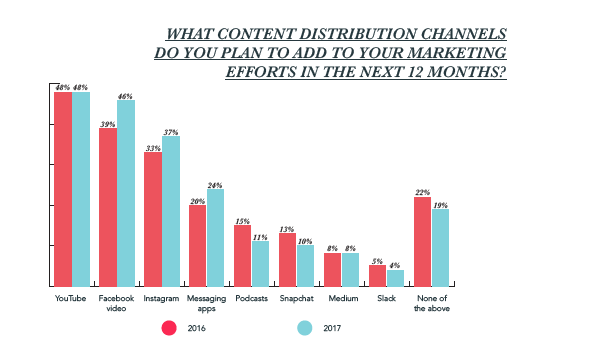HubSpot has just released their 9th annual State of Inbound Report, which provides an in-depth review of how the process of doing business has changed, and how “companies are rising to the challenge to meet consumers where they are—whether that’s on Facebook, YouTube, in a messaging app, or on a mobile device.” With over 6,000 respondents weighing in, this year’s report will show you the direction that sales and inbound marketing is heading, and will help you to become more forward-thinking in your strategic planning over the coming year, especially in relation to your content marketing.
How does your inbound marketing strategy need to evolve in 2017?
Out of those respondents surveyed, the majority had the same marketing goals over the next 12 months: to convert contacts and leads into customers and to increase website traffic. These stats haven’t really changed year over year; in fact, HubSpot’s annual reports consistently show that these are main goals for most businesses and marketers. But now that the way we do business is constantly evolving, how can we continue to achieve these goals successfully? One of the answers is in content marketing and distribution.
“If a company is slow to capture a new mode of communication, it might as well stop the business”
When respondents were asked about the future of inbound marketing, they unanimously agreed that the primary content distribution channels which we’ve always used — email, blog, website — are no longer sufficient by themselves. In fact, 47% of marketers surveyed said their top inbound marketing priority is improving their content distribution. But there are so many channels available, which should you focus on to stay relevant and competitive?

YouTube
Video was one of the top-rated “disruptors” in HubSpot’s State of Inbound survey, with 48% of marketers planning to add YouTube to their content distribution strategy in the next 12 months.
People don’t have the same amount of time or patience to read through full-text articles or posts anymore; instead, they “snack” on content via video posts or live broadcasting. To further convince you, here are a few other jaw-dropping statistics to help fuel your push towards a video strategy in 2017:
- Including video in an email can lead to a 200 – 300% increase in click-through rates.
- Just by simply using the word “video” in an email subject line, you can boost your open rates by 19%, click-through rates by 65%, and reduces unsubscribe rates by 26%.
- YouTube reaches more 18+ year olds during prime-time TV hours than any cable network.
- Google estimates advertisers on prime time broadcast TV could have reached 56% more 18-49 year olds by also advertising on YouTube.
- 90% of shoppers say that seeing a video is helpful in the decision process
- Including a video on a landing page can increase conversion rates by 80%
Facebook Video
Since it’s launch to the public last year, Facebook Live has taken social media by storm. In fact, 46% of marketers plan to add Facebook video to their content distribution strategy in the next 12 months, up 7% from last year.
Live is the best way to interact with viewers in real time and build raw, honest connections. Field their questions, hear what’s on their mind and check out their Live Reactions to gauge how your broadcast is going.
You can broadcast to the largest audience in the world with the camera in your pocket.
As argued in the statistics listed above, people love watching video, and Live allows your current followers to engage in real time via their Newsfeed, and will allow new followers to discover you as well in the Live feeds “around the world” section of Facebook.
Instagram is another content channel that businesses are looking to work more with in 2017. Over 5 million businesses currently use the social media platform for paid advertising, social media marketing and building brand awareness and community. With over 80% of Instagram’s 700 million users following a business on Instagram, it’s an essential tool that you should be actively using in your marketing strategy.
Not only are Stories a huge success for both individual creators and businesses, but Instagram Live has taken off as successfully as Facebook Live, and given users the ability to livestream and broadcast their daily lives and events as well.
In addition, Instagram began testing their new shopping experience last fall, which has been successful thus far: “Businesses will also soon be able to get insights around the metrics that matter to them, like how many people tapped to see more product details or clicked on “shop now.” By telling businesses more about their audience and which posts are performing well, they can create more relevant content. All of this is part of our continuing efforts to strengthen relationships between people and the brands they love, by creating more opportunities—and simpler ways—to discover and explore products on Instagram.”
Messaging Apps
The State of Inbound’s results have found that an increase in the use of messaging apps such as WhatsApp and WeChat is predicted to disrupt the way that a lot of salespeople and marketers do their jobs. Results show that 24% of marketers plan to add messaging apps to their content distribution strategy in the next 12 months, up 4% from last year.
We want to be contacting our customers where, when and how they want to be contacted, and if that means moving towards a new form of communication, then so be it. Companies must be prepared to be flexible in adapting to these new technologies, and be educated on how to conversationally reach out to their customers via these messaging apps — canned and pre-planned email responses just won’t cut it when the conversations are live and instant.
WeChat also offers functionality to deliver broadcast messaging to your users, such as articles or media, as well as offers, membership cards and discounts.
Podcasts
Content marketing is a way to tell your customers your story, and there is no better way than via a Podcast. The content is quick, accessible, and easily consumable — since your attention isn’t required to read or watch it, it can be listened to while walking, driving, cooking dinner, or even while working.
If you look at the top ranking Podcasts available on podbay.fm, you’ll see a significant number of them are business or industry-related. They are a great way to become more intimate with your followers and build a community, and are distributable through multiple channels; not only can you broadcast through your blog or website, but you can reach a more global audience via iTunes or Soundcloud.
Snapchat
The majority of the non-millennial business world is still struggling with the best and most effective way to use Snapchat, but it is a direction you should look into for 2017. With over 166 million users and an average of 30 minutes spent per day on the platform, there are a ton of unique opportunities available for you to interact with your followers.
With the requirement to provide compelling content within a 10 second timeframe, Snapchat’s paid advertising drives creativity and efficiency. You can tailor your ad delivery to reach audiences based on their habits, lifestyle categories, and demographics, and through integration with partners like Datalogix and Nielsen Catalina, their analytics even have the ability to help you determine the impact your Snapchat media may have had on driving offline, in-store purchases.
Summary
To read more about HubSpot’s insights and predictions for the State of Inbound in the coming year, including data on artificial intelligence, what processes are impacting sales and marketing functions, and how to improve your inbound ROI, get your free copy of the 2017 report, available now.


